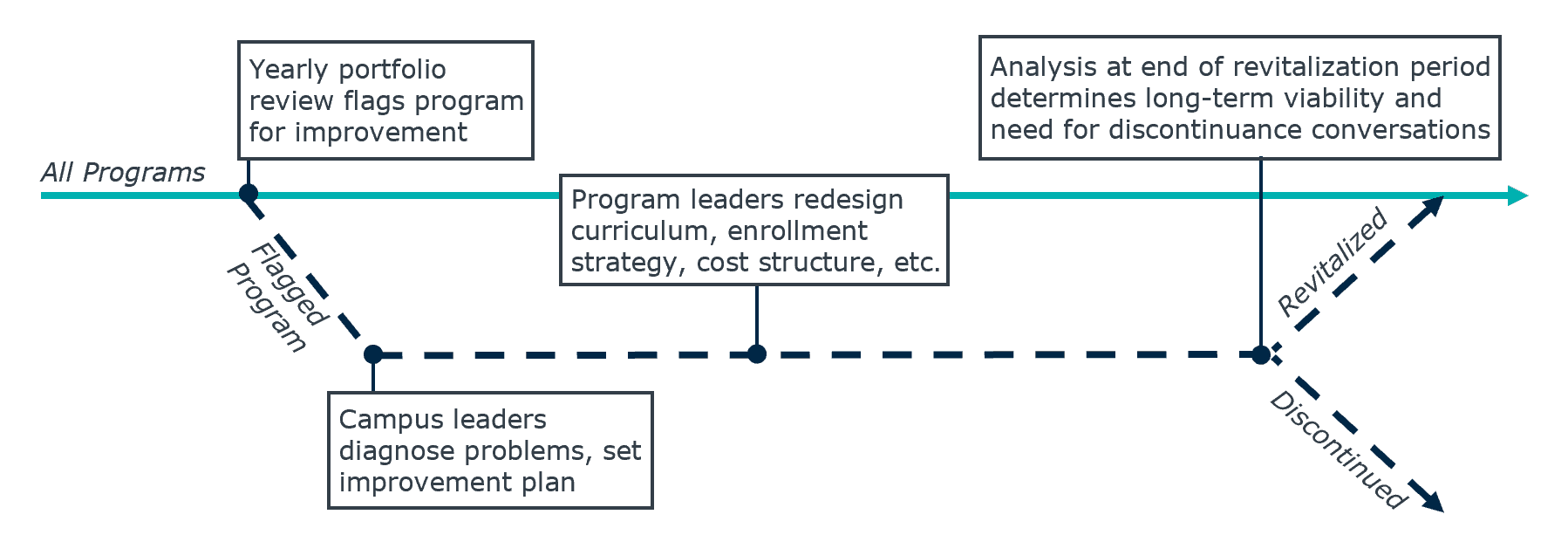Revitalize your athletics portfolio in a tumultuous landscape
Two steps to examine athletics through a strategic review
March 25, 2025, By Mary Frances Harris, Associate Director, Research
Over the coming months and years, EAB believes that higher education institutions must assess the financial stability of their athletic departments and how athletics supports the institution’s strategy (rather than the reverse). Institutions must ask tough questions about which sports to continue to invest in and where changes and cuts need to be made. This challenging task requires institutions to evaluate a variety of factors during their decision-making process. Absent an effective strategy to review and realign the athletics portfolio, institutions risk the depletion of their financial and reputational resources.
Applying lessons learned from academic portfolio review to athletics departments
Institutions can learn from best practices in academic portfolio review when tackling the challenge of reviewing their athletics programs. EAB endorses a systemic and routine approach to academic portfolio review that fosters a continuous improvement mindset, rather than relying on one-off, herculean efforts. Annual program assessments guide strategic decision-making about revitalization and discontinuance of programs in a structured and transparent way. This approach to annual health checks for academic programs may provide a useful framework for institutions to apply to a strategic review of the athletics portfolio.
Like academic program review, athletic program review teaches us that programs contribute in different ways. Tie your review process to one or more of the following goals:
- Brand enhancement
- Yield support
- NTR growth
- Retention support
Adapt the academic review process to foster a continuous improvement mindset in athletics. Then, follow steps one and two below to identify and revitalize your athletics portfolio.

Step 1: Monitor the right data
There is no shortage of data in athletics, but not all metrics are useful when evaluating program success. For each team, select program-specific metrics that acknowledge the diversity of program types and goals.
Brand enhancement
Track the quantitative metrics of athletic competitiveness and the qualitative measures of department and team success.
Sample impact metrics:
- External media coverage
- Ticket sales to non-students
- Local community attendance
- Athlete community service and engagement
Yield support
Focus on roster management by comparing current and historical roster sizes to ideal size and current capacity.
Sample impact metrics:
- Roster sizes
- Recruitment pipeline health
- Prospective student interest in participation
- Number of JV and reserve teams
NTR growth
Calculate net tuition revenue contributions from current and former student-athletes.
Sample impact metrics:
- Student-athlete aid
- Unfunded aid
- Athletic department costs
- Cost per student-athlete
- Team-specific costs
Retention support
Monitor the root causes of ineligibility that lead to stop-outs.
Sample impact metrics:
- Institutional retention rates
- In-sport retention rates
- Satisfaction with coaching
- Graduation rates
- End-of-season GPAs
Step 2: Revitalize flagged sports
Once you have created your athletic watch list, implement interventions that align with program goals.
- Brand enhancement: Prioritize competitive and institutional goals when determining how to allocate athletics resources. Create a tiered system to equitably differentiate investments (e.g., coaching and support staff) to align with each team’s brand and desired outcomes.
- Yield support: Enhance coaches’ enrollment and retention responsibilities by requiring and executing a recruitment plan and counseling students on academic and other issues.
- NTR growth: Fine-tune your aid strategy to ensure that increases in student-athlete headcount are not offset by higher discount rates.
- Retention support: Reduce academic ineligibility and stop-outs with mandatory study halls and GPA monitoring.
The goal and expectation of the review process should be to align athletics programs with institutional strategy and set athletics on a financially sustainable path. EAB does not recommend discontinuance as a primary action, but there may be cases where cutting a sport is appropriate. Instead, opt for other cost-cutting strategies like limiting travel, supplementing coaching staff with graduate assistants, and aligning administration and student support with existing services.
Check out EAB’s athletics resources, like our Student-Athlete Net Revenue Contribution Calculator and New Sport Launch Playbook, for additional support as you navigate the shifting landscape of college athletics. If you’d like to discuss your institution’s athletics strategy and priorities, contact [email protected].

More Blogs

3 strategies for leading your university through unprecedented change

Beyond ROI: What the New Fed Data Misses About Higher Ed’s Value Crisis
